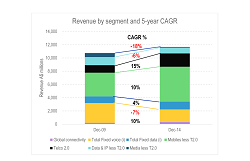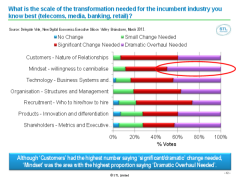
Telco network edge computing: Lessons from early movers
Drawing from the experience of Lumen, SK Telecom, Telefónica, Verizon and Vodafone, this report identifies the steps, partnerships and expectations of a successful telco edge strategy.


Drawing from the experience of Lumen, SK Telecom, Telefónica, Verizon and Vodafone, this report identifies the steps, partnerships and expectations of a successful telco edge strategy.

Singtel’s data analytics business, DataSpark, has achieved some impressive results, but scaling is hard. Its path highlights lessons on dealing with the challenges facing all telcos building new businesses, e.g. how to govern and manage relationships with the broader organisation, measuring success, and finding the right skills and partners.

What can others learn from SK Telecom’s advanced efforts to grow in the face of declining core telecoms revenues? 5G is a part of the story, but not all of it.

Telcos are looking towards the enterprise market to make the business case for 5G. But for most industries, 5G is just one of many technologies needed to drive efficiency and innovation. Which verticals’ needs best match telcos’ capabilities?

What other telcos can learn from AT&T’s and Verizon’s rapidly diverging strategies in the digital advertising market.

Telcos with a clear focus on what they are trying to achieve will do better at the risky business of M&A. So who’s buying what, and who’s doing well?

M&A is a key tool in building digital businesses, but is the telco sector investing enough? We examine the key drivers and barriers to telco digital M&A strategies, comparing investment levels to other verticals, and compare and contrast M&A activity with our previous findings.

When Amazon Web Services (AWS) landed in Australia in 2012, everyone expected carnage for Australian carriers. Telstra’s Network Applications & Services division, though, is growing fast and making some interesting moves. How did Telstra do it, and what else can be learned from its successes and its latest moves into the Healthcare market?

Value is squeezed out of industries as they become increasingly digital – i.e. accessed by mobile and online, driven by data and defined by software. We call the collective economic impact of this pressure ‘The Great Compression’. But which companies will survive and prosper – and how? 90% of the Execs at our Silicon Valley brainstorm identified ‘management mindset’ as a key factor in Telecoms, Media, Finance and Retail. Our analysis and a detailed report of the findings of the Digital Economy session at the NDE Executive Brainstorm, Silicon Valley, held at the InterContinental Hotel, San Francisco on the 19th March 2013. (May 2013, Executive Briefing Service, Transformation Stream).
Scale of Transformation Needed April 2013